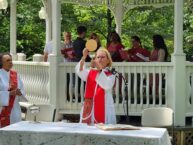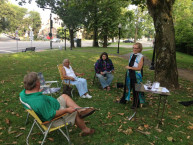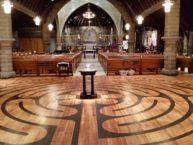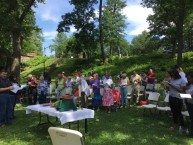February 22, 2015: May God’s words alone be spoken, may God’s words alone be heard. Amen.
You gotta love some of the church signs these days… “If you are praying for snow…please stop!” or “I’m giving up winter for Lent – who’s with me?” I don’t know about you, but about now, I am done with Winter! All this ice, snow, sleet, shoveling… done I tell ya. In fact, when I opened the garage door this morning and saw about half a foot of snow on the driveway, I thought – I am leavin’ it right there until spring, and backed the truck right over it. And I find it rather humerous that in the midst of snowacoplyses, snowmaggedons, and whatever other headline our inane media comes up with, we begin Lent with another weather nightmare – the great flood…or at least, the aftermath of it.
In Genesis, the Earth is recovering from the effects of God’s anger with humanity – and perhaps, after taking a look at it all, and maybe taking a long look in the divine mirror, God realizes that it was a mistake on a cosmic level. Promising not to ever do this again, God says that the bow in the clouds during any future rain will be a sign to God not to go too far, saying “it shall be a sign of the covenant between me and the earth…I will see it and remember the everlasting covenant between God and every living creature of all flesh that is on the earth.”
It’s a great story, and a fav of Sunday School classes everywhere…even popular on nursery walls. Which is all kind of funny when you think about the story, right? I mean, it is really cute to have one of those toy arks…you know, with two giraffes, and two monkeys, and of course, two elephants – you gotta have elephants. Now, you gotta wonder how all THAT is supposed to work, all crammed in there on that boat, no matter how many cubits it is. In fact, I am guessing that today this would never happen. I think today, it would go a bit like this…
It seems that when God was starting the big storm, God looked around and there was no Ark! “”Noah.” God shouted, “Where is the Ark?”
“God, please forgive me!” cried Noah. “I did my best but there were big problems. First, I had to get a permit for construction and your plans did not comply with the codes. I had to hire an engineering firm and redraw the plans. And, they just wouldn’t accept the idea that I didn’t need egress to a local road because the ark would just float out of my yard. Then I got into a fight with OSHA over whether or not the Ark needed a fire sprinkler system and floatation devices. Then my neighbor objected, claiming I was violating zoning ordinances by building the Ark in my front yard, so I had to get a variance from the city planning commission.
I had problems getting enough wood for the Ark, because there was a ban on cutting trees to protect the Spotted Owl. I finally convinced the U.S. Forest Service that I needed the wood to save the owls. However, the Fish and Wildlife Service won’t let me catch any owls. So, no owls. And, when I started rounding up the other animals, I got sued by an animal rights group. They objected to me only taking two of each kind aboard.
Just when I got the suit dismissed, the EPA notified me that I could not complete the Ark without filing an environmental impact statement on your proposed flood. They didn’t take very kindly to the idea that they had no jurisdiction over the conduct of the Creator of the universe. Then the Army Corps of Engineer demanded a map of the proposed new flood plain……..I sent them a globe.
The IRS has seized all my assets, claiming that I’m building the Ark in preparation to flee the country to avoid paying taxes. I just got a notice from the State that I owe some kind of user tax and failed to register the Ark as a ‘recreational water craft.’
Finally the ACLU got the courts to issue an injunction against further construction of the Ark, saying that since God is flooding the earth, it is a religious event and therefore unconstitutional.
I really don’t think I can finish the Ark for another 5 or 6 years!”
The sky began to clear, the sun began to shine and the seas began to calm. A rainbow arched across the sky.
Noah looked up hopefully. “You mean you are not going to destroy the Earth, God?”
“No,” said God. “When they all die, they might just bring that bureaucracy up here, and I want no part of that headache!”
But funny as it might seem, the actual story in the bible is neither funny nor cute. In anger, God responds violently…and then regrets what has happened – the whole scale destruction of not only wicked humanity, but the innocent animals. As usually happens with violence, there is collateral damage. The flood story is about a reaction to bad things in a violent way… God just hit the reset button – responding to violence with whole scale violence in the name of justice…and then sees that isn’t a great solution.
From this realization, God enters into a covenant with all of creation. Now note…God doesn’t enter into a covenant with humanity, but with ALL of creation. Remember that the passage reads:
God says “it shall be a sign of the covenant between me and the earth…I will see it and remember the everlasting covenant between God and every living creature of all flesh that is on the earth.”
God is promising this to everyone and every living thing – to the birds, the dogs, the cats, the elephants, the hippos, all of it. And when we, the ones made in God’s image, abuse any of that creation, we are effectively acting in a very un-Godly like manner. There is, for God, no difference in the promise made for humanity and for the rest of God’s creation. God will be at peace with all of it. And maybe that is why Jesus, in our gospel lesson today, is able to hang out with the wild beasts in the wilderness. There is no indication he is battling them. Quite the contrary. The text says,
“He was in the wilderness forty days, tempted by Satan; and he was with the wild beasts; and the angels waited on him.”
I picture him tossing a ball to a big lion, or maybe taking a nap with some rhinos. A sign of the peaceable kingdom perhaps, or maybe that the creatures emulate God far more than we as humans do. It is said that humans are the only creature that blushes, or has need to, for we are the only creatures that commit acts of violence outside of a need for food or in defense of ourselves. And this week we hear of even more violence…the murder of 21 Coptic Christians by terrorists in Libya. “Think about life in our world at the moment and how God’s heart must despair at our inhumanity [(or perhaps more truly our indivinity).]
God must be looking at the rainbow!”[1]
And it would seem that we need a sign ourselves.
We, the ones made in God’s image, seem unable at times to live in peace with one another, and we certainly are at war with creation in the way we live in utter disregard for it. But, perhaps we can take heart that there is always a new beginning that is possible. And the sign of that new beginning for God was the rainbow.
We look at the rainbow as a sign of God’s covenant with us, but, and here is the best part of the whole story…the sign of the covenant, the rainbow, is not for us – it never was. The sign of the covenant is for God – it is a reminder to God – for God to see, and to remember.
What does it mean for us? What does it mean that God needs signs? That God needs a reminder – something to focus on to bring God back to what is really important? What does it mean that God essentially was giving up something to return home to the fullness of relationship between Creator and created?
Perhaps in this understanding of God, the one who needed a sign as a reminder, we can most see ourselves, the ones created in God’s image. Perhaps too it is in our observance of Lent that we most seek a sign that will orient us, that will point us to not only model what is important, but to right relationship. Lenten disciplines are reminders or signs of our identity, more than a denial. And in this first Sunday of Lent we hear a reminder of what God gave up – violence against the created. And to remember that promise, God had a sign.
So what is our sign? What can we look to that will help us to return home to relationship with God, and all of God’s creation?
We know the answer.
We know the answer, because God gives up something else to give us one.
God becomes human…think of what God is giving up to do this – God willing stepping into a place of vulnerability, death, exposure, pain, hurt. Why? Perhaps God realizes, as we do, that the rainbow was a reminder to God, but that we humans needed something too. We needed a sign – a way of returning to right relationship of Creator and created. And we receive that in the life, death, and resurrection of Jesus. Out of our own violence of the cross, we are able to look at that symbol of oppression and see it as a reminder of love and grace.
We enter into this period of Lent with the intention of focusing, and to do that, we often give up, or take on, new disciplines that will serve as reminders to us of what is important. But just having a sign, without responding to it, is meaningless.
If God looked at the rainbow, but then shrugged the divine shoulders and said “what the heck, I’m God, kaboom!” the sign, and what it represents, would be an exercise in futility. The sign must lead to transformation. In God’s case, to easing of the anger that one can hardly blame God for having in the first place.
Think about it. Imagine if you created something so incredibly beautiful, gave it some people to someone to care for, and they not only destroyed it, but harmed one another in the fight over it, how would you feel? Pretty darned angry. I know it would make me want to wipe them all out – hit the reset button – start all over. I would need some sort of reminder – a way to count to 10. But the point of that sign, of counting to 10, isn’t to delay, but to change. The purpose of the sign is to change God from anger to covenant – a covenant that requires nothing on our part – it is unconditional.
The purpose of Lent is to change us too. To bring us back into right relationship with God. Not because God has turned away – remember, God’s love for us is unconditional. No, the purpose of Lent is to remind us of who we are, and to guide us back into the fullness of that loving bond – to help us to feel that love, even when we walk in our own wilderness. Even when the world feels like a wilderness.
God needed a reminder of who God was, to keep the Creator in right relationship with the created. That sign was the rainbow among the grey clouds.
We need a reminder of who we are, the ones created in the image of God. And in Lent, we enter into a wilderness time in the hope that in the greyness of our Lenten journey, we, being stripped of all that pulls us from our Creator, may see the sign of who we are – the sign given to us by God – the sign of the incarnation – of Jesus. And his life, his death, and his resurrection, we were given a symbol of God’s love for us, God’s desire to be in relationship with us – that when we look upon it, it might be a reminder to us of who we are, and that we might be transformed back into right relationship of Creator and created.
“I give you my Word,” said God and the Word became flesh and dwelt among us, full of grace and truth.[2]
Thanks be to God for the sign that saves us from ourselves. Amen.
[2] Madeleine L’Engle, The Rock That is Higher: Story as Truth (Wheaton, 1993).
[Sermons as written may not be as delivered on any given Sunday]Rev. Diana L. Wilcox
Christ Church in Bloomfield & Glen Ridge
February 22, 2015
First Sunday of Lent
1st Reading – Genesis 9:8-17
Psalm 25:1-9
2nd Reading – 1 Peter 3:18-22
Gospel – Mark 1:9-15






